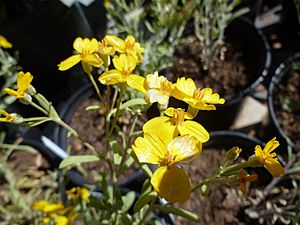Woolly paperflower facts for kids
Psilostrophe tagetina is a beautiful flowering plant often called the woolly paperflower. It belongs to the daisy family, which includes many well-known flowers like sunflowers and daisies! This plant is special because it has soft, woolly leaves and bright flowers.
Quick facts for kids Woolly paperflower |
|
|---|---|
 |
|
| Scientific classification | |
| Kingdom: | |
| (unranked): | |
| (unranked): | |
| (unranked): | |
| Order: | |
| Family: | |
| Tribe: | |
| Genus: |
Psilostrophe
|
| Species: |
P. tagetina
|
| Binomial name | |
| Psilostrophe tagetina (Nutt.) Greene
|
|
| Varieties | |
|
P. t. var. cerifera |
|
Contents
Where the Woolly Paperflower Grows
The woolly paperflower is native to several parts of North America. You can find it growing naturally in Arizona, Colorado, Kansas, New Mexico, Oklahoma, Texas, and Utah in the United States. It also grows in northwestern Mexico.
How People Use Woolly Paperflower
For a long time, different Native American tribes have found many uses for the woolly paperflower. They used it for both practical purposes and traditional medicine.
Traditional Uses by Native Americans
The Ramah Navajo people used a strong liquid made from the plant. This was sometimes used to help the body clean itself out. They also used it to treat stomachaches.
The plant was also used as an eyewash to help with eye problems. Sometimes, it was made into a lotion to soothe itchy skin. For a sore throat, they might gargle with a cold liquid from the plant. They also made a soft pack, called a poultice, from the leaves to put on a sore throat.
Making Yellow Dye
The Keres, Zuni, and White Mountain Apache tribes used the flowers of the woolly paperflower to make a bright yellow dye. This dye could be used for coloring fabrics or other materials.
Other Medicinal Uses
The Zuni people also made a special poultice from the plant's root. This was used as a traditional treatment for rattlesnake bites.

